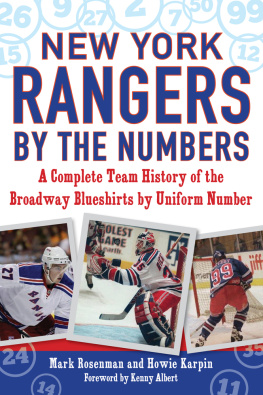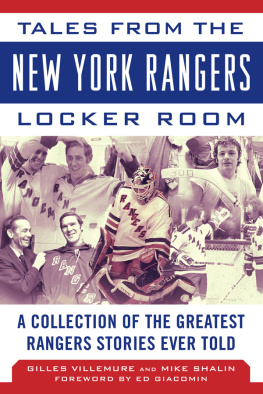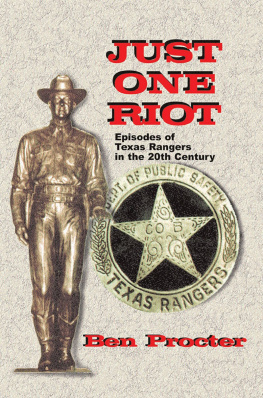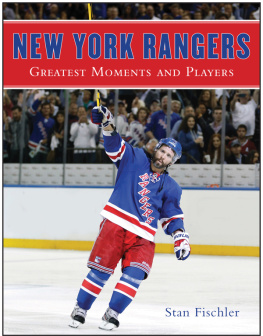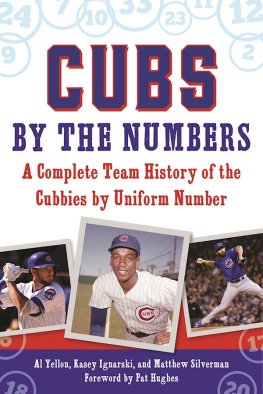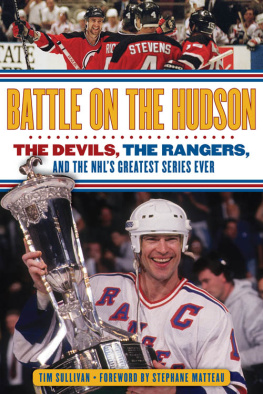Copyright 2018 by Mark Rosenman and Howie Karpin
Foreword copyright 2018 by Kenny Albert
All rights reserved. No part of this book may be reproduced in any manner without the express written consent of the publisher, except in the case of brief excerpts in critical reviews or articles. All inquiries should be addressed to Sports Publishing, 307 West 36th Street, 11th Floor, New York, NY 10018.
Sports Publishing books may be purchased in bulk at special discounts for sales promotion, corporate gifts, fund-raising, or educational purposes. Special editions can also be created to specifications. For details, contact the Special Sales Department, Sports Publishing, 307 West 36th Street, 11th Floor, New York, NY 10018 or .
Sports Publishing is a registered trademark of Skyhorse Publishing, Inc., a Delaware corporation.
Visit our website at www.sportspubbooks.com.
10 9 8 7 6 5 4 3 2 1
Library of Congress Cataloging-in-Publication Data is available on file.
Cover design by Tom Lau
Cover photo credit: AP Images
Print ISBN: 978-1-68358-177-2
Ebook ISBN: 978-1-68358-178-9
Printed in the United States of America
Mark:
This book is dedicated to Marv Albert,
who allowed me to see my first Ranger game
on the radio. I was hooked with the very first
He shoots, he scores!
Howie:
I dedicate this book to Ruth and Sidney Karpin,
my late mother and father.
My dad took me to my first hockey game
at the old Madison Square Garden
over 50 years ago and Ive been
a huge fan ever since.
CONTENTS
FOREWORD BY KENNY ALBERT
Ive been a passionate hockey fan since I was very young and was very familiar with jersey numbers, especially the New York Rangers numbers.
When I was fourteen years old, I got an opportunity to be the official statistician for New York Rangers radio broadcasts. The play-by-play announcer just happened to be my dad, Marv Albert. The relationship did not make it any easier for me, as I still needed to put the work in. With the fast-paced play and continuous substitutions on the ice, recognizing the players by their jersey numbers became an integral part of the job.
In 1990, I began my professional broadcasting career as the play-by-play announcer for the Baltimore Skipjacks (a minor-league affiliate of the Washington Capitals). Five years later, I was named the radio voice of the Rangers and have been on the job ever since. Ive been privileged to be a TV play-by-play announcer for NHL games, but radio is where you really need to recognize the numbers that are worn by the players on the ice.
Recognizing the sweater numbers that encompass the Rangers glorious history is what New York Rangers by the Numbers is all about. Throughout the proud history of the Rangers franchise, the sweater numbers have always inspired historical references, trivia questions, and fond memories for their loyal fan base.
Seven Ranger numbers (for eight players) hang in the rafters at Madison Square Garden, but they will be joined by one more in the 201718 season.
From #1 Eddie Giacomin to #99 Wayne Gretzky and every number in-between, the glorious history of a proud franchise is told in this book through the single and double digits that graced the Ranger sweater. Mark Rosenman and Howie Karpin went deep into the archives to unearth everyone and anyone who ever wore the Ranger uniform throughout the ninety-year history of the franchise.
It is said that a picture tells a thousand words, but a sweater number tells a thousand stories.
Kenny Albert
#1: EDDIE, EDDIE, EDDIE
Ed Giacomin
NYR Debut: October 24, 1965 (vs. Montreal Canadiens, lost 43)
Regular Season Games with NYR: 538
Playoff Games with NYR: 65
Also wore: #23 and #30
Thirty-eight goaltenders have worn #1 for the New York Rangers, but Eddie Giacomins #1 is one of seven retired numbers (for eight players, soon to be joined by Jean Ratelles #19) that hang in the rafters at Madison Square Garden.

Eddie Giacomin was the second Ranger to have his number retired.
Hockey Hall of Famer Frank Patrick created a numerical system to identify players positions on the ice that debuted in the Pacific Coast Hockey League beginning with the 191112 season.
Patrick numbered the players from the-goal-out, so the goaltender was #1.
Giacomins career began as a nineteen-year-old with the Washington Presidents of the Eastern Amateur Hockey League in 1958. He played in the final four games of the season and won all of them, which assured him a spot on next years team. The following season, the franchise moved to Clinton, New York, and became the Comets. Giacomin was hired as an assistant trainer and back-up goaltender, but later that season was sent to the Providence Reds of the American Hockey League.
During his five years in Providence, Giacomin caught the eye of a Ranger scout who tipped off head coach Emile Francis about the acrobatic goaltender. In May of 1965, the Rangers acquired Giacomin from Providence in exchange for four minor leaguers including backup goalie Marcel Paille who also wore #1 and had played seven years for the Rangers.
On October 24, 1965, Giacomin made his Rangers and National Hockey League debut at Madison Square Garden against the Montreal Canadiens and lost, 43, but it was the beginning of an 11-year career in New York.
It was a struggle for Giacomin early on in his Rangers tenure. The fans were impatient with the twenty-six-year-olds inconsistent play, so they booed him and rode him pretty hard. But as he kept at it, Giacomin started to develop as a goaltender and so did the fans affection for him.
From the 19651966 through the 196970 seasons, Giacomin led the NHL in games played. His workload decreased in the 197071 season, but with good reason as he shared the Vezina Trophy with Gilles Villemure (who wore #30).
Giacomin never won a Stanley Cup with the Rangers, but he helped them get there in 1972 against the Boston Bruins. Giacomin, who had injured his knee in the Rangers semifinal, four-game sweep of Chicago, was awful in Game One as he yielded 6 goals on 28 shots.
After being replaced by Villemure in Game Two, Giacomin returned to the net and won Game Three. His knee acted up again in a Game Four loss and he did not play for the remainder of the series as the Rangers lost in six.
October 29, 1975, is marked as an infamous date in Ranger history. It was the day that Giacomin was placed on waivers and claimed by the Detroit Red Wings. The Red Wings first game after making the claim was against the Rangers at Madison Square Garden.
November 2 became a memorable night in Garden history as Giacomin started the game in a Red Wings uniform. The crowd gave him a raucous and prolonged standing ovation, and actually rooted for him over the home team throughout the game. Detroit won the game, 64.
Giacomins #1 became the second number to be retired by the team (Rod Gilberts #7 was first) on March 15, 1989. He was inducted into the Hockey Hall of Fame in 1987.
Lorne Gump Worsley
NYR Debut: October 9, 1952 (at Detroit Red Wings, lost 52)
Regular Season Games with NYR: 582
Playoff Games with NYR: 20
Lorne Gump Worsley began his Hall of Fame career with the Rangers in 1952, when he captured the Calder Memorial Trophy as the National Hockey Leagues Rookie of the Year.

